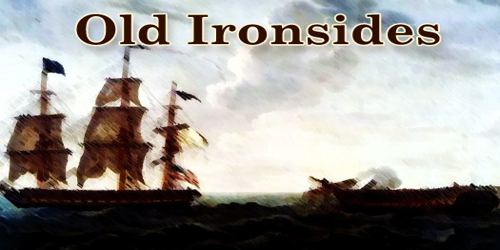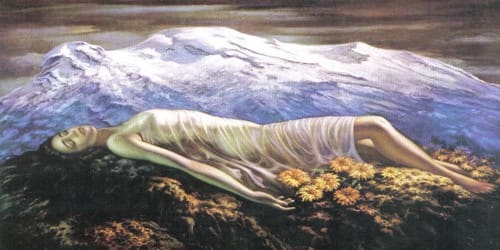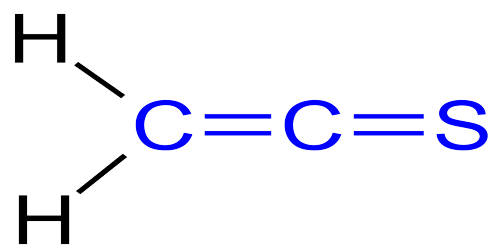“Ay, tear her tattered ensign down!
Long has it waved on high,
And many an eye has danced to see
That banner in the sky.”
In 1833, when the old war ship Constitution, unfit for service, lay in the navy yard in Charlestown, the Secretary of the Navy decided to sell her or to break her up. On the appearance of this bit of news in a Boston paper, Oliver Wendell Holmes, a law student at Harvard, scribbled some verses and sent them to the editor.
This poem of twenty-four lines was at once published, and was soon copied into the leading newspapers of the country. In our large cities, the poem was circulated as a handbill. Popular indignation rose to a white heat, and swept everything before it.
The order was at once revoked, and Congress decided that the old frigate, so dear to the hearts of the American people, should be rebuilt.
Why did the people care so much about “Old Ironsides?”
For twenty-five years after the adoption of the Constitution, we had a rough road to travel. We were nearly crushed by our foreign debts, and could do little to defend ourselves on the high seas. England boarded our ships and carried off our sailors, and France captured our vessels and stole their cargoes. Even the Barbary pirates, when they spied the new flag, began to plunder and burn our merchantmen, and sell their crews into slavery.
In the fall of 1793, eight Algerine pirate craft sailed out into the Atlantic and within a month had captured eleven of our ships and made slaves of more than a hundred of our sailors.
Think of our consul at Lisbon writing home, “Another Algerine pirate in the Atlantic. God preserve us!”
In behalf of American citizens held as slaves by these pirates, a petition was sent to Congress. A bill was then passed, allowing President Washington to build or to buy six frigates.
It was a fortunate day for our nation when the plans of Mr. Humphreys, a shipbuilder of Philadelphia, were accepted. He was directed by Congress to prepare the models of six war ships, to be built in different towns on the coast.
The design of the Constitution was sent to Boston, and her keel was laid in Hartt’s Naval Yard, near what is now Constitution Wharf. The ideas of Mr. Humphreys were carried out to the letter. The new frigate was to have better guns, greater speed, greater cruising capacity, in fact, was to be a little better in every respect than the British and the French ships of the same rating.
The Constitution was called a forty-four-gun frigate, although she actually carried thirty twenty-four-pounders on her main deck, and twenty-two thirty-two-pounders on her spar deck. She had one gun deck instead of two, and her cannon were heavier than were usually carried on foreign war ships of her own class. She was twenty feet longer and about five feet broader than the far-famed thirty-eight-gun British frigates. In comparison with a modern war ship, she was less than one half as long as the armed cruiser New York, and not far from the size of one of our gunboats.
The British naval officers made much sport of these new ships; but after “Old Ironsides” had destroyed two fine British frigates, and had out sailed a large British fleet, they went to work and made over some of their line of battle ships into large frigates.
The Constitution was built of the best material, and with unusual care. A Boston shipwright was sent South to select live oak, red cedar, and hard pine. Paul Revere, who made the famous midnight ride to Concord, received nearly four thousand dollars for the copper which he furnished for the new frigate.
From the laying of the keel to the final equipment, the Constitution was kept in the shipyard fully three years. Her live oak timbers, having had two years to season, were hard as iron.
After many delays, the stanch ship was set afloat at midday, October 21, 1797, “before a numerous and brilliant collection of citizens.”
In 1803, a fleet was sent to the north of Africa, to force the pirates of the Barbary coast to respect the persons and the property of American citizens. Commodore Preble was made commander, with the Constitution as his flagship. He had under him the Philadelphia, a fine new frigate, and five smaller war ships.
Preble was a remarkable man, and his “schoolboy captains,” as he called them, all under twenty-five years of age, were also remarkable men.
For two years or more, there was plenty of stubborn fighting. Within forty days, five attacks were made on the forts and the war ships of Tripoli. In three of these attacks, the Constitution took part; and once, while supporting the fleet, she silenced more than a hundred guns behind the forts of the pirate capital.
Even from the first, the new frigate was lucky. She was never dismasted, or seriously injured, in battle or by weather. In all her service, not one commanding officer was ever lost, and few of her crew were ever killed.
On one occasion, six of our gunboats made a savage hand to hand attack on twenty-one Tripolitan gunboats, and drove them back into the harbor with great loss.
“There, Commodore Preble,” said young Decatur, as he came over the side of the Constitution, and walked joyfully up to his commander on the quarter-deck, “I have brought you out three of the gunboats.”
Preble had a kind heart, but a very quick temper. Like a flash, he seized Decatur by the collar and shook him, shouting, “Aye, sir, why did you not bring me out more?” and walked into his cabin.
The stern old fighter was over his temper in a moment. He sent for his young officer, and made ample amends for bad temper and hasty words. Ever afterwards these two great men were the best of friends.
During the war of 1812, “the war for free trade and sailors’ rights,” the Constitution won her chief honors. The story of her remarkable escape from a British squadron has been often told.
It was at daybreak about the middle of July, 1812, off the New Jersey coast. Not a breath ruffled the ocean. Captain Isaac Hull, every inch of him a sailor, was in command. A British fleet of five frigates and some smaller vessels, which had been sighted the day before, had crept up during the night, and at daylight almost surrounded “Old Ironsides.”
Hull knew his ship and his men. Not for one moment did he think of giving up his vessel. Of course he could not fight his powerful foe with his single ship. He must get away. But how?
One of the British frigates, the Shannon, had furled her sails, and was being towed by all the boats of the fleet.
“This,” said Lieutenant Morris, “seemed to decide our fate.”
A moment later, however, a puff of wind carried our frigate out of gunshot.
“How deep is the water?” shouts Captain Hull.
“Twenty fathoms,” is the reply.
“Out with the kedge anchor!” cries Hull.
All the spare ropes and cables are fastened together and payed out to an anchor, which is dropped into the sea a mile ahead. The sailors on the frigate go round the windlass on the run, and the vessel is slowly drawn ahead to the anchor, which is now quickly taken up and carried out once more. This is called kedging.
Our sailor boys give cheer on cheer as they whirl the windlass and pull at the oars.
The captain of one of the enemy’s frigates now sees the game, and tries kedging, but does not get near enough to throw a shot.
Three of the pursuing frigates open fire at long range, without doing any damage.
All day long this pursuit is kept up. Every gun is loaded, ready to fire. The men rest by the cannon, with their rammers and their sponges beside them. All the next day the chase goes on. At last, slowly but surely, the American frigate gains on her pursuers. At four o’clock in the afternoon, the Shannon is four miles astern.
Two hours later, a squall gave Hull a chance to play a trick on his pursuers. Sail was shortened the moment the squall struck. The British captain, seeing the apparent confusion on board the Yankee frigate, also shortened sail. The moment his vessel was hidden by the rain, Hull quickly made sail again. When the weather cleared, his nearest pursuer was far astern.
At daylight the next morning, the British fleet was almost out of sight and, after a chase of three nights and two days, gave up the contest.
Six days later, the good people of Boston went wild with delight, as their favorite frigate ran the blockade and came to anchor in the harbor.
Captain Hull was not the man to be shut up in Boston harbor if he could help it. In less than two weeks he ran the blockade and sailed out upon the broad ocean. A powerful British fleet was off the coast. Hull knew it, but out he sailed with his single ship to battle for his country.
Now the British had a fine frigate named the Guerrière. This vessel was one of the fleet that had given the Constitution such a hot chase a few days before. Captain Dacres, her commander, and Captain Hull were personal friends, and had wagered a hat on the result of a possible battle between their frigates. The British captain had just written a challenge to the commander of our fleet, saying that he should like to meet any frigate of the United States, to have a few minutes tête-à-tête.
On the afternoon of August 19, about seven hundred miles northeast of Boston, these two finest frigates in the world, the Guerrière and the Constitution, met for the “interview” that Dacres so much wanted.
All is hurry and bustle on “Old Ironsides.”
“Clear for action!” shrilly sounds the boatswain’s whistle.
The fife and drum call to quarters. Everybody hurries to his place.
The British frigate, as if in defiance, flings out a flag from each topmast. Her big guns flash, but the balls fall short.
“Don’t fire until I give the word,” orders Captain Hull.
Now the Guerrière, drawing nearer and nearer, pours in a broadside.
“Shall we not fire, sir?” asks Lieutenant Morris.
“Not yet,” is Hull’s reply.
Another broadside tears through the rigging, wounding several men. The sailors are restless at their double-shotted guns.
Now the two frigates are fairly abreast, and within pistol shot of each other.
“Now, boys, do your duty. Fire!” shouts the gallant commander, at the top of his voice.
Hull is a short and stout man. As he leans over to give the order to fire, his breeches burst from hip to knee. The men roar with laughter. There is no time to waste, however, and so he finishes the battle in his laughable plight.
An officer, pointing to the captain, cries, “Hull her, boys! Hull her!”
The men, catching the play upon words, shout, “Hull her! Yes, we’ll hull her!”
“Old Ironsides” now lets fly a terrible broadside at close range. The Guerrière’s mizzenmast goes overboard.
“My lads, you have made a brig of that craft!” cries Hull.
“Wait a moment, sir, and we’ll make her a sloop!” shout back the sailors.
Sure enough, the Guerrière swings round and gets a raking fire, which cuts away the foremast and much of the rigging, and leaves her a helpless hulk in the trough of the sea. The flag goes down with the rigging, and there is nothing to do but to surrender.
In just thirty minutes, the British frigate is a wreck.
During the hottest part of the battle, a sailor, at least so runs the story, saw a cannon ball strike the side of the vessel and fall back into the sea.
“Hurrah, boys! hurrah for ‘Old Ironsides’!” he shouted to his mates; “her sides are made of iron.”
Some say that from this incident the nickname of “Old Ironsides” took its origin.
Captain Hull received his old friend Dacres, kindly, on board the Constitution, and said, “I see you are wounded, Dacres. Let me help you.”
When the British captain offered his sword, Hull said, “No, Dacres, I cannot take the sword of a man who knows so well how to use it, but I will thank you for that hat!”
Just as they were ready to blow up the Guerrière, Dacres remembered that a Bible, his wife’s gift, which he had carried with him for years, had been left behind. Captain Hull at once sent a boat after it.
Twenty-five years after this incident, Captain Dacres, then an admiral, gave Hull a dinner on his flagship, at Gibraltar, and told the ladies the story of his wife’s Bible.
When “Old Ironsides” came sailing up the harbor, on the last day of August, what a rousing reception the people of Boston gave Captain Hull and his gallant men!
All the people of the town crowded the wharves or filled the windows and the housetops overlooking the bay. The streets were gay with bunting, and there was a grand dinner, with many patriotic speeches and deafening cheers.
In less than five months after her battle with the Guerrière, the Constitution had her hardest fight. It was with the Java, one of the best frigates in the British navy. Her commander, Captain Lambert, was said to be one of the ablest sailors that ever handled a war ship. The battle took place some thirty miles off the northeast coast of Brazil.
The Constitution was commanded by Captain William Bainbridge. Before this, he had done some feats of seamanship, but thus far in his career he had not been fortunate. As you remember, Captain Bainbridge, through no fault of his own, lost the Philadelphia off the harbor of Tripoli.
The battle began about two o’clock in the afternoon, with broadsides from both frigates.
Bainbridge was soon wounded in the hip by a musket ball; then the wheel was shattered, and a small copper bolt was driven into his thigh. Unwilling to leave the deck a moment, he had his wounds dressed while directing the battle.
Finding that he could not get near enough to the swift British frigate, Bainbridge boldly headed for the enemy. There was great risk of getting raked, but fortunately the Java’s shots went wild.
“Old Ironsides” was now within close range of the Java, and the fire of her heavy cannon soon left the British frigate dismasted and helpless. The British did not surrender, however, until every stick in the ship except a part of the mainmast had been cut away.
Captain Lambert was mortally injured, his first lieutenant severely hurt, and nearly fifty men were killed and more than one hundred wounded. “Old Ironsides” came out of the battle with every spar in place.
The wheel of the Java was removed and fitted on the Constitution, to replace the one which had been shot away.
A few years after the war, some British naval officers paid a visit to “Old Ironsides.”
“You have a most perfect vessel,” said one of them, “but I must say that you have a very ugly wheel for so beautiful a frigate.”
“Yes,” said the American captain to whom the remark was made, “it is ugly. We lost our wheel in fighting the Java, and after the battle we replaced it with her wheel, and somehow we have never felt like changing it.”
Bainbridge was a great-hearted and heroic man. When he was told that Captain Lambert was mortally injured, he forgot his own wounds and had his men carry him to the blood-stained quarter-deck, where the British officer lay. He then put into the dying man’s hand the sword he had just surrendered.
On Captain Bainbridge’s return to Boston, another long procession marched up State Street, and another grand dinner was given. When he traveled by coach to Washington, the people along the route turned out in great crowds to honor the naval hero.
The Constitution fought her last battle off the Madeira Islands, on February 20, 1815, under the command of Captain Charles Stewart, one of the hardest fighters in the history of our navy.
“What shall I bring you for a present?” said Captain Stewart to his bride.
“A British frigate,” promptly replied the patriotic young wife.
“I will bring you two,” answered Stewart.
On the afternoon of February 20, two British men-of-war hove in sight. They proved to be the frigate Cyane and the sloop of war Levant.
“Old Ironsides” made all sail to overhaul them.
Stewart’s superb seamanship in this sharp battle has excited the admiration of naval experts, even to our own day. It is generally admitted that no American ship was ever better handled. He raked one vessel and then the other, repeatedly. Neither of the enemy’s war ships got in a single broadside.
Just forty minutes after Stewart’s first fire, the Cyane surrendered. A full moon then rose in all its splendor, and the battle went stoutly on with the Levant. At ten o’clock, however, she, too, perfectly helpless, struck her colors.
“Old Ironside’s” last great battle was over. Singlehanded, she had fought two British war ships at one time and defeated them, and that, too, with only three men killed and twelve wounded. In less than three hours our stanch frigate was again in fighting trim.
With the exception of long periods of rest, “Old Ironsides” carried her country’s flag with dignity and honor for forty years.
Her cruising days ended just before the outburst of the Civil War, in 1861, when she was taken to Newport, Rhode Island, to serve as a school-ship for the Naval Academy. Later, she was housed over, and used as a receiving ship at Portsmouth, New Hampshire. In the fall of 1897, she was towed to the navy yard at Charlestown, to take part in her centennial celebration, October 21, 1897.
The old Constitution has been rebuilt in parts, and repaired many times; so that little remains of the original vessel except her keel and her floor frames. These huge pieces of her framework, hewn by hand from solid oak, are the same that thrilled with the shock of the old guns, before the granite forts of Tripoli. Over them floated the American flag and the pennants of Preble, Hull, Bainbridge, Decatur, Stewart, and many other gallant men, whose heroic deeds have shed luster on the American navy.
It is interesting to know that Commodore Stewart was the last survivor of the great captains of the war of 1812. He served his country faithfully for seventy-one years, and lived to be ninety-one. He died at his home, called “Old Ironsides,” in New Jersey, in 1869.
The loss of a few frigates did not matter much to England, but the loss of her naval prestige in the war of 1812 was of importance to the whole world. For the first time, Europe realized that there was a new nation, which was able and willing to fight for its freedom on the ocean, as it had fought for its independence on land.
“Old Ironsides” still survives, a weather-beaten and battle-scarred hull, but a precious memorial of the nation’s glory. She has earned a lasting place in the affections of the American people.
Written by Albert F. Blaisdell
















